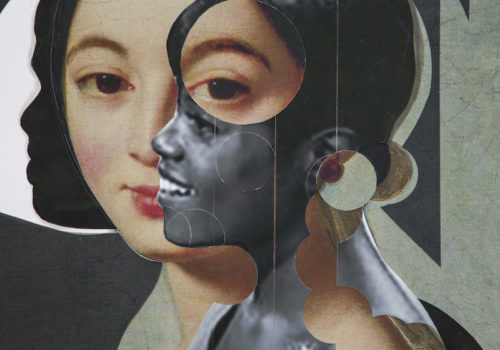Cannot talk about the place I came from
I do not want it to exist
The way I knew it
In the language of my captor
– Shane McCrae
On view at Elizabeth Houston Gallery, Gary Burnley’s eponymous series In the Language of My Captor recasts the venerable tradition of 18th- and 19th-century European portraiture, carving out a space for alternate narratives whose central figures were not afforded the commensurate stature of the grand manner of painting.
The discipline of portraiture has historically been a grasping at social status and economic power, giving permanence to the idealized visions of beauty it describes. But Burnley imbues the medium with a doubly disruptive capacity, juxtaposing and overlapping imagery from different periods and sources, and softening their discrepancies with circular cutouts. Reframing an Ingres, Courbet, or Coypel, he populates their canvases with those who have been left outside the art historical cannon, centering the lives of Black women, men, and children at the core of cultural dialogue. Through the bricolage and universal appeal of the circle as symbol of unity and timelessness, he retells old tales in new inflections.
So it is with Burnley’s often conflicting and contradictory representations, brought together seamlessly under the auspices of collage. Portraits of Marie Antonette, of the artist’s grandmother and preschool classmates, of Mona Lisa and Emmett Till—whose murder sparked the civil rights movement and struck fear into the hearts of generations—of family picnics, unknowns, and the artist himself, are intricately interwoven in his work, upending habitual interpretations. His Knock, Knock (2019) transforms Seymour Joseph Guy’s Story of Golden Locks (ca. 1870), a genre painting of Guy’s children reading the fable, through the insertion of the silhouette Flora (1796) as the elder daughter’s shadow on the bedroom wall. In 1796, there were two options for recording one’s likeness: the expensive portrait, and the 25-cent silhouette, a profile tracing made by candlelight in a matter of minutes. Flora is one of the few known images of an enslaved person in 18th-century America, accompanying a bill of sale for the 19-year-old woman for 25 pounds sterling in Fairfield County, CT. The contradictions, embedded squarely within the space of Burnley’s collaged portrait, raise profound questions.
As Burnley explains it, it is not so much that Black Americans inhabit a different world from their white counterparts, but that they “live in the same world differently.” Compelling new “collaborations” between 18th-century paintings and 20th-century school yearbooks, between family photos and found imagery, he subverts art historical traditions and generates new, more inclusive readings through amalgamation. If portraits have been used historically to depict power and wealth, to solidify conceptions of virtue, beauty, and taste, they are equally capable of disrupting the meanings they establish. Gary Burnley’s work does not jettison the language of portraiture altogether, but rather reconstructs it beyond recognition, making it fit to tell different stories.
Robyn Day
Robyn Day is a Chicago-based photographer and freelance writer for Photograph Magazine. She previously wrote art criticism for WBUR, Boston’s NPR news station, and Art New England.
Gary Burnley (b. St. Louis, Missouri) received a BFA from Washington University in St. Louis and an MFA from Yale University. His work is part of museum and private collections in US including the Virginia Museum of Art, Richmond, VA, Hunter Museum of American Art, Chattanooga, TN., Weatherspoon Art Museum, University of North Carolina and the Marieluise Hessel Collection, Bard College. Solo and group exhibitions include Aperture Gallery, NY, Ogden Museum, New Orleans, LA, Tbilisi University, Tbilisi, Georgia, Candela Gallery, Richmond, VA, SALON, Florence, Italy, Honey Ramaka Gallery, Brooklyn, NY, Contemporary Arts Museum, Houston, TX, Artists Space, NY. A Photolucida Critical Mass 2020 Top 50 Selection, Burnley was the 2020 Blue Sky Solo Show Winner, a 2019 FotoFilmic Mesh Award finalist, a finalist for the Clarence John Laughlin Photography Award in 2018 and has been the recipient of individual artist fellowships and commissions from the National Endowment for the Arts, the State of Connecticut, New York State Council on the Arts, Creative Artist Public Service Program, NYC, MTA, NYC and Bi-State Development, Saint Louis, Missouri.
Gary Burnley : In the Language of My Captor
From February 24 through April 24, 2021
Elizabeth Houston Gallery
190 Orchard Street
New York, NY 10002
www.elizabethhoustongallery.com
















